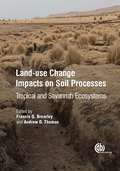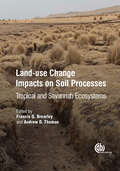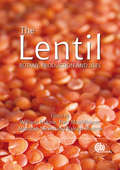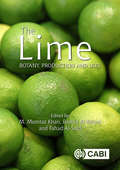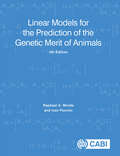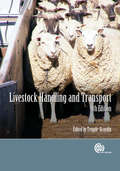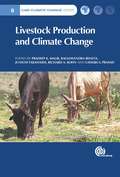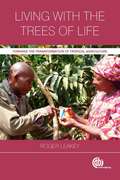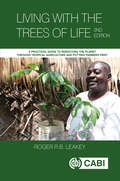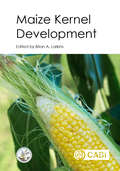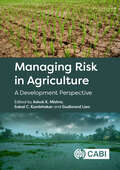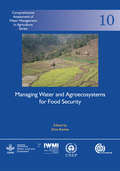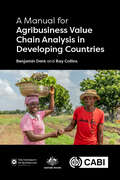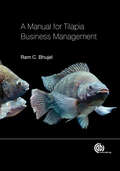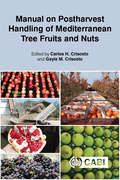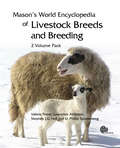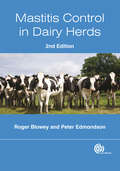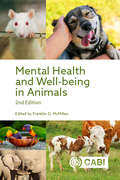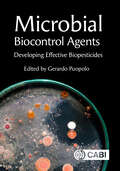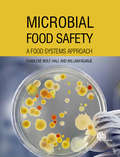- Table View
- List View
Land-Use Change Impacts on Soil Processes
by Subrata Ghoshal Chaudhuri Heather D’angelo Raghavan Dinesh Francis Brearley Caitlyn Gillikin Andrew Thomas Arkalgud Ganeshamurthy Krista Mcguire Dina MerrerThis book examines the effects that land-use changes (notably agricultural intensification, logging, soil erosion, urbanisation and mining) have on soil characteristics and processes in tropical and savannah environments. It covers a range of geographical regions and environments as impacts of land use change are often site specific. The effects of land use change on various aspects of the soil ecosystem from both a chemical and biological perspective will be examined.
Land-Use Change Impacts on Soil Processes: Tropical and Savannah Ecosystems
by Raghavan Dinesh Arkalgud Ganeshamurthy Subrata Ghoshal Chaudhuri Heather D’Angelo Krista McGuire Caitlyn Gillikin Dina MerrerThis book examines the effects that land-use changes (notably agricultural intensification, logging, soil erosion, urbanisation and mining) have on soil characteristics and processes in tropical and savannah environments. It covers a range of geographical regions and environments as impacts of land use change are often site specific. The effects of land use change on various aspects of the soil ecosystem from both a chemical and biological perspective will be examined.
Lentil
by Fred Muehlbauer Balram Sharma Ashutosh Sarker William ErskineIn the last three decades, the global production of lentils has almost tripled due to larger harvest areas but also more importantly from progress in research and productivity. Chapters outline improvements in production, such as water and soil nutrient management, agronomy, mechanization and weed management. Developments in genetics and breeding are discussed alongside improved knowledge of the lentil's origin, domestication, morphology and adaptation. The implementation and impact of this new research at the farm level is also addressed as well as the crop's post-harvest processing and nutritional value.
The Lime
by M. Mumtaz Khan Rashid Al-Yahyai Fahad Al-SaidThis book is a comprehensive and up-to-date resource covering the botany, production and uses of limes. The lime is an important fruit crop throughout citrus producing regions of the world, with its own specific benefits, culture and marketplace, but producers face issues affecting successful cultivation and production. The Lime: Botany, Production and Uses contains detailed information on: #65533; Breeding, genetics and biodiversity of limes #65533; Orchard establishment, management and precision agriculture #65533; Pests and diseases, including the latest knowledge regarding current threats such as Witches' Broom Disease and Citrus Greening #65533; Harvesting and postharvest management #65533; Traditional and commercial uses of limes Authored by an international team of experts and presented in full colour throughout, this book is an essential resource for academic researchers and specialist extension workers, in addition to growers and producers involved in the citrus industry.
Linear Models for the Prediction of the Genetic Merit of Animals
by Raphael A Mrode Ivan PocrnicFundamental to any livestock improvement programme by animal scientists, is the prediction of genetic merit in the offspring generation for desirable production traits such as increased growth rate, or superior meat, milk and wool production. Covering the foundational principles on the application of linear models for the prediction of genetic merit in livestock, this new edition is fully updated to incorporate recent advances in genomic prediction approaches, genomic models for multi-breed and crossbred performance, dominance and epistasis. It provides models for the analysis of main production traits as well as functional traits and includes numerous worked examples. For the first time, R codes for key examples in the textbook are provided online. The book covers: - The relationship between the genome and the phenotype. - BLUP models for various livestock data and structure. - Incorporation of related ancestral parents and metafounders in prediction models. - Models for survival analysis and social interaction. - Advancements in genomic prediction approaches and selection. - Genomic models for multi-breed and crossbred performance. - Models for non-additive genetic effects including dominance and epistasis. - Estimation of genetic parameters including Gibbs sampling approaches. - Computation methods for solving linear mixed model equations. Suitable for graduate and postgraduate students, researchers and lecturers of animal breeding, genetics and genomics, this established textbook provides a thorough grounding in both the basics and in new developments of linear models and animal genetics.
Livestock Handling and Transport
by Temple GrandinEdited by world-renowned animal scientist Dr. Temple Grandin, this practical book integrates scientific research and industry literature on cattle, pigs, poultry, sheep, goats, deer, and horses, in both the developed and developing world, to provide a practical guide to humane handling and minimizing animal stress. Reviewing the latest research on transport systems, restraint methods and facilities for farms and slaughterhouses, this fully updated fourth edition of Livestock Handling and Transport includes new coverage of animal handling in South America, and reviews extensive new research on pig transportation in North America.
Livestock Handling and Transport
by Temple GrandinEdited by world-renowned animal scientist Dr. Temple Grandin, this practical book integrates scientific research and industry literature on cattle, pigs, poultry, sheep, goats, deer, and horses, in both the developed and developing world, to provide a practical guide to humane handling and minimizing animal stress. Reviewing the latest research on transport systems, restraint methods and facilities for farms and slaughterhouses, this fully updated fourth edition of Livestock Handling and Transport includes new coverage of animal handling in South America, and reviews extensive new research on pig transportation in North America.
Livestock Production and Climate Change
by Pradeep K. Malik Cadaba S Prasad Raghavendra Bhatta Richard Kohn Junichi TakahashiIn a changing climate, livestock production is expected to exhibit dual roles of mitigation and adaptation in order to meet the challenge of food security. This book approaches the issues of livestock production and climate change through three sections: I. Livestock production, II. Climate change and, III. Enteric methane amelioration. Section I addresses issues of feed quality and availability, abiotic stress (heat and nutritional) and strategies for alleviation, livestock generated nitrogen and phosphorus pollution, and approaches for harnessing the complex gut microbial diversity. Section II discusses the effects of climate change on livestock diversity, farm animal reproduction, impact of meat production on climate change, and emphasising the role of indigenous livestock in climatic change to sustain production. Section III deals with the most recent approaches to amelioration of livestock methane such as breeding for low methane emissions, reductive acetogenesis, immunization/vaccine-based concepts and archaea phage therapy.
Livestock Production and Climate Change
by Cadaba S PrasadIn a changing climate, livestock production is expected to exhibit dual roles of mitigation and adaptation in order to meet the challenge of food security. This book approaches the issues of livestock production and climate change through three sections: I. Livestock production, II. Climate change and, III. Enteric methane amelioration. Section I addresses issues of feed quality and availability, abiotic stress (heat and nutritional) and strategies for alleviation, livestock generated nitrogen and phosphorus pollution, and approaches for harnessing the complex gut microbial diversity. Section II discusses the effects of climate change on livestock diversity, farm animal reproduction, impact of meat production on climate change, and emphasising the role of indigenous livestock in climatic change to sustain production. Section III deals with the most recent approaches to amelioration of livestock methane such as breeding for low methane emissions, reductive acetogenesis, immunization/vaccine-based concepts and archaea phage therapy.
Living with the Trees of Life
by Roger LeakeyBased on the career of Roger Leakey, the former Director of Research at the International Centre for Research in Agroforestry, this book presents the experiences of real life situations in rural villages of remote and distant places. Living with the Trees of Life demonstrates how the multi-disciplinary science of agroforestry, which embraces biology, genetics, ecology, agronomy, horticulture, forestry, soil science, food science, and the social sciences, can offer hope from the doom and gloom often emanating from the tropics. Written in an accessible and engaging style that will appeal to both a professional and general readership, this book takes a more positive approach to the issues facing agriculture and highlights an innovative approach to resolving the big issues of poverty, malnutrition, hunger and environmental degradation including climate change.
Living With the Trees of Life: A Practical Guide to Rebooting the Planet through Tropical Agriculture and Putting Farmers First
by Roger LeakeyWith our world torn by climate change, deforestation, land degradation, hunger, malnutrition, poverty, loss of wildlife habitat, zoonotic pandemics, illegal migration and social injustice, this book seeks to find a practical and pragmatic way forwards. Based on the author's extensive experience of tropical agriculture and forestry around the world, as well as his combination of practical and academic agricultural qualifications, the second edition of Living with the Trees of Life presents a unique and positive perspective on resolving these big global issues. It aims to identify principles, strategies, techniques, and skills to find a path through the maze of options for sustainable living in the tropics and subtropics. The book specifically draws heavily on a single case study which involved working to resolve the failure of tropical and subtropical agriculture to feed, sustain and support the needs of rural communities. To address the 'big picture' facing society, the work identified the traditionally important indigenous trees of tropical ecosystems - the trees of life - as a missing component of farming systems. These trees are keystones of the natural environment. Their products and critical ecological and social services have been overlooked by modern agriculture and should be recognized as the natural capital of the environment providing the very many day-to-day needs of local people. Many of today's big problems can be traced back to the breakdown of the natural, social and human capital of farming systems. Hence, a focus on restoring the natural capital also has important benefits for the livelihoods of the rural population, as well as for the productivity of the agroecosystem. However, the real potential is to go much further and to build new natural capital in the form of new socially-modified tree crops producing a very wide range of food, medicinal and other non-food products for new local business enterprises. This then restores the degraded social and human capital and starts to create new physical and financial capitals much needed for employment and economic development. There is, however, a missing 6th capital - the political and social will to change the way we manage our world by re-booting tropical agriculture and putting the needs of local people at the forefront of farming systems. Drawing on the technologies from across the spectrum of current conventional approaches to agricultural production, Living with the Trees of Life seeks to promote the adoption of a new way ahead - described as Land Maxing - that also increases the returns on past investments in agriculture. The target readership of this book is a wide and diverse array of people engaged in advocating and/or adopting ways to address the issues affecting our divided and dysfunctional world, before it is too late. Written in an accessible and engaging style, this book tells the story of how a new area of crop science has emerged across the tropics to create highly nutritious crops which can enhance food security and start to address the big issues facing humanity. Thus, this book is a vital read for academics, policy makers, and the environmentally and socially aware public alike.
Maize Kernel Development
by Philip Becraft Jim Birchler Ljudmilla Borisjuk Prem S. Chourey Joanne Dannenhoffer Matthew Evans Sherry Flint-Garcia José Gutiérrez-Marcos Jeff Habben Curt Hannah Tracie Hennen-Bierwagen Gregorio Hueros Gwyneth Ingram Shawn Kaeppler Karen Koch Dr Brian A Larkins Fangfang Ma Don McCarty Jo Messing Alan Meyers Keith Roesler Hardy Rolletschek Paolo Sabelli Jeff Schussler Bo Shen Bill Sheridan Rentao Song Erik Vollbrecht Thomas Widiez Yongrui Wu Ramin Yadegari Junpeng ZhanThis is an authoritative book that acts as a guide to understanding maize kernel development. Written by a team of experts, it covers topics spanning pre- and post-fertilization events, embryo and endosperm development, grain filling and maturation, and factors influencing crop yield. It explores the significance of maize and other cereal grains, existing hypotheses and research, and important gaps in our knowledge and how we might fill them. This is a valuable resource for researchers of maize and other cereals, and anyone working on basic or applied science in the fields of seed development, plant genetics, and crop physiology.
Managing Risk in Agriculture: A Development Perspective
by Tahirou Abdoulaye Rachidi Aboudou Aminou Arouna Victor Barrera Toritseju Begho Marrit Van Berg Pratap S. Birthal Martina Bozzola Selina Bruns Jean-Paul Chavas Simone Cerroni Juan Dominguez Marcella D’Souza Ali Essossinam Hongli Feng Ricardo Fort J Brian Hardaker Jaweriah Hazrana David A. Hennessy Maman H. Karmana Aditya R. Khanal Seo Woo Lee Sergio H. Lence Lu Liu Fulco Ludwig Abel-Gautier Kouakou Alfons G.J.M. Lansink Wanglin Ma Hui Mao Miranda P.M. Meuwissen Digvijay S. Negi Kehinde Odeniyi Asis Kumar Senapati Ariel Singerman Arjuna Srinidhi Ruggiero Rippo Nicholas Tyack Puneet Vatsa Alexis H. Villacis H. Holly Wang Saskia E. Werners Tesfamicheal Wossen Eliana Wulandari Xiaoheng Zhang Hongyun ZhengThe book addresses and documents farmers' risks in developing and emerging economies. It draws lessons from experimental economics on measuring risk preferences, attitudes, gender differences in managing risks, and risk management strategies in countries across Africa and Asia. It argues policy makers, especially in emerging economies, need a better understanding of farmers' attitudes toward risk and choices of risk management strategies when designing policies to support production agriculture. The book includes chapters on three themes: understanding risk attitudes and preferences; using experimental economics to measure risk, preferences, and risk management strategies; and understanding climate change, risk, and risk management. The book critically examines the currently held beliefs about risk preference, attitudes, and empirical estimation of risk management strategies, emphasizing developing and emerging economies (DEE). "The agricultural development space is an inherently risky one and this welcome collection belatedly helps to plug an important hole." Jock R. Anderson, Emeritus Professor of Agricultural Economics, University of New England, Armidale, Australia "Over time, agricultural production practices have evolved, as have the markets and value chains for food and agricultural products. A constant consideration, however, and one that continues to define agriculture worldwide, is risk. The risks that impinge on agriculture come in all shapes and sizes. Of course, production risks are ubiquitous. But so are market risks. And the same is true for macroeconomic and financial risks and the risks associated with an evolving climate. This book will be a valuable, comprehensive resource for any applied economist desiring to understand the risk management principles relevant to modern food and agricultural systems." Matthew Holt, Prof. and head of the Department of Agricultural and Applied Economics, Virginia Tech University, Blacksburg, VA, USA.
Managing Water and Agroecosystems for Food Security
by Eline BoeleeWater protection, food production and ecosystem health are worldwide issues. Changes in the global water cycle are affecting human wellbeing in many places, while widespread land and ecosystem degradation, driven by poor agricultural practices, is seriously limiting food production. Understanding the links between ecosystems, water, and food production is important to the health of all three, and sustainably managing these connections is becoming increasingly necessary. This book shows how sustainable ecosystems, especially agroecosystems, are essential for water management and food production.
Managing Water and Agroecosystems for Food Security (Comprehensive Assessment Of Water Management In Agriculture Ser.)
by Eline BoeleeWater protection, food production and ecosystem health are worldwide issues. Changes in the global water cycle are affecting human wellbeing in many places, while widespread land and ecosystem degradation, driven by poor agricultural practices, is seriously limiting food production. Understanding the links between ecosystems, water, and food production is important to the health of all three, and sustainably managing these connections is becoming increasingly necessary. This book shows how sustainable ecosystems, especially agroecosystems, are essential for water management and food production.
A Manual for Agribusiness Value Chain Analysis in Developing Countries
by Dr Benjamin Dent Professor Ray CollinsValue Chain Analysis (VCA) diagnoses the current state of a value chain and makes recommendations to improve its effectiveness and efficiency. Applying VCA in developing countries is very often subject to limited time and funding. This manual shows how VCA principles can be applied under such circumstances. It explains how to undertake an affordable VCA that still generates valid data and so produces recommendations that will have impact. The manual has four parts: Part 1: Our Approach to Value Chain Thinking - sets out the principles and practice of taking a value chain approach. Part 2: Conducting Value Chain Analysis - covers planning a VCA, conducting consumer research, interviewing, analysing, creating recommendations and reporting. Part 3: Case Studies - illustrates successful VCAs with case studies e.g. Ghanaian pineapples and Kenyan indigenous chicken. Part 4: Further Reading and Biographies The practical style and content will make this manual accessible to a wide audience: NGO practitioners; government policymakers and extension officers; private sector managers and consultants; and academics for teaching and researching.
Manual for Tilapia Business Management
by Ram BhujelTilapias are an increasingly important farmed fish for human consumption. Hailed as an important source of protein for growing populations, production is set to double within the next ten years and expand beyond traditional areas of production in Africa and Asia. With a practical focus, this book is aimed at tilapia farmers and producers, describing best practice production methods, egg management, new technologies, nutrition, business practices, marketing, equipment maintenance, accounting and logistics.
Manual for Tilapia Business Management
by Ram BhujelTilapias are an increasingly important farmed fish for human consumption. Hailed as an important source of protein for growing populations, production is set to double within the next ten years and expand beyond traditional areas of production in Africa and Asia. With a practical focus, this book is aimed at tilapia farmers and producers, describing best practice production methods, egg management, new technologies, nutrition, business practices, marketing, equipment maintenance, accounting and logistics.
Manual on Postharvest Handling of Mediterranean Tree Fruits and Nuts
by Cristina Besada Reinaldo Campos-Vargas Giancarlo Colelli Joseph H Connell Gemma Echeverria Louise Ferguson Margarita López Corrales Amnon Lichter George Athanasios Manganaris Sebastián Sáa Silva Alejandra Salvador Manuel Joaquín Serradilla Sánchez Daniel Valero GarridoPostharvest is an important element of getting fresh, high-quality fruit to the consumer and technological advances continue to outpace infrastructure. This book provides valuable, up-to-date information on postharvest handling of seven fruit and nut crops: almond, fig, peach, persimmon, pistachio, pomegranate and table grape. These crops are of particular importance in the Mediterranean region, but also to those countries that export and import these crops, where intensive economic resources are dedicated to developing information to understand and solve their postharvest problems. Written by a team of internationally-recognized postharvest experts, this manual collates and verifies essential, but often difficult to access, information on these important crops, that is pertinent to the world's agricultural economy and affects agricultural communities. The book: Covers relevant postharvest topics for each crop across harvesting, packing, shipping and retail postharvest phases. Has an emphasis on knowledge useful to solve current worldwide industry problems. Includes practical recommendations. Makes available for the first time in English information previously published in other languages. Includes up-to-date references and high-quality photos that make it an excellent resource for postharvest educators and students. This is a must-have manual for growers and commodity handlers, cold storage managers, transportation personnel, produce managers and retail handlers, researchers, or anyone in the food chain that packs, transports, stores and sells these fruits and nuts.
Mason's World Encyclopedia of Livestock Breeds and Breeding: 2 volume pack
by Valerie Porter D. Phillip Sponenberg Stephen Hall Lawrence AldersonMason's World Encyclopedia of Livestock Breeds and Breeding describes breeds of livestock worldwide as well as a range of breed-related subjects such as husbandry, health and behaviour. This definitive and prestigious reference work presents easily accessible information on domestication (including wild ancestors and related species), genetics and breeding, livestock produce and markets, as well as breed conservation and the cultural and social aspects of livestock farming. Written by renowned livestock authorities, these volumes draw on the authors' lifelong interest and involvement in livestock breeds of the world, presenting a unique, comprehensive and fully cross-referenced guide to cattle, buffalo, horses, pigs, sheep, asses, goats, camelids, yak and other domesticants. Volume 1: contains asses, camelids, cattle, goats, horses and pigs Volume 2: contains sheep, water buffalo, yak and other livestock Coverage: Breed descriptions: including groups, types and varieties, history and links between groups, livestock products and trends for creating new breeds Wild species: ancestral and relatives, potential domesticants and hybridization Humans and breeds: spread of domestication, transhumance and pastoralism, social and cultural influences, suitability of different groups for different human purposes Genetics and Conservation: a dedicated section and glossary of terms Placing breeds in a practical agricultural context, this two volume encyclopedia will be of great value to agriculturalists, breeders, geneticists, biologists, rural historians, conservationists, ecologists, and all those who are interested in the rich diversity of livestock breeds.
Mastitis Control in Dairy Herds
by Peter Edmondson Roger BloweyMastitis in dairy herds is a worldwide problem, with significant implications for milk yields and quality, economic losses, and animal health and welfare. Effective control makes a considerable difference to the farmer and the animal, and this new edition includes updated information throughout as well as new chapters covering organic dairy herds, dry period infections, robotic milking, residue avoidance, and best practice procedures. The authors, both fellows of the Royal College of Veterinary Surgeons and recognised experts in the field, provide basic principles relevant to farmers, vets and veterinary students in a clear and practical way, covering anatomy, epidemiology, milking machines, disinfection, somatic cell counts, and diseases of the udders and teats in order to provide a thorough understanding of the causes of mastitis and measures of control and prevention. It is an indispensable resource for large animal vets, dairy industry personnel, farm managers, dairy herdsmen, and researchers and students in animal sciences and related disciplines.
Mental Health and Well-being in Animals
by Dr Gina Alvino Melissa Bain Ngaio J Ngaio J C. A. Buffington Larry Carbone Kathy Carlstead Sharon Crowell-Davis Dr Victoria Cussen Ian J.H. Duncan Carine Elkhoraibi Daniel Q. Estep Temple Grandin Sophie S. Hall Suzanne Hetts Debra F. Horwitz Gary Landsberg Lori Marino David J. Mellor Professor Michael Mendl Professor Daniel Mills Karen L. Overall Elizabeth S. Paul Pamela J. Reid Claire Ricci-Bonot Lauren M. Robinson Amy Robinson-Junker Lynne M. Seibert David Shepherdson Daniel M. Weary Alexander Weiss Jacqueline Wilhelmy James W. YeatesThe second edition is fully revised, expanded, and comprehensively updated with the most current knowledge about the full array of mental health issues seen in animals. Written by key opinion leaders, internationally-recognized experts and specialists, it is comprehensive covering basic principles to mental wellness, emotional distress, suffering and mental illness, through to measurement and treatment. With even more practical information and clinical pearls, this book remains invaluable to veterinary professionals, animal welfare researchers and advocates, and other animal caregivers.
Microbial Biocontrol Agents: Developing Effective Biopesticides
by Abhishek Anand Marc Bardin Ana Bejarano Elisa Bona Tito Caffi Hamza Chammem Antonieta De Cal Margherita Furiosi Elisa Gamalero Bernard R. Glick Belén Guijarro Lars Huber Dr Ajay Kumar Inmaculada Larena Sara E. Legler Carla S. Lorenz Paloma Melgarejo Hassan Momeni Fahimeh Nazari Andrea Nesler Philippe Nicot Ma. del Orozco-Mosquedab Ilaria Pertot Thomas Pressecq Dr Gerardo Puopolo Vittorio Rossi Naser Safaie Gustavo Santoyo Selena Tomada Estelle Turc Maria Villarino Mout De Vrieze Laure WeisskopfThe negative impact of chemical pesticides on human wellbeing and the environment has encouraged the development of eco-friendly alternatives for the management of plant pathogens. However, only a small number of microbial biocontrol agents (mBCAs) have been developed, registered and used in the management of plant diseases. This book analyses the deployment of mBCAs for the development of novel microbial biopesticides, considering the main plant-beneficial traits, procedures needed for effective formulations and the processes used for their validation. To guide the readers through the world of microbial biopesticides, the book starts with a chapter dedicated to the regulations that need to be followed for the development of final products. Readers will understand the importance of formulation and mode of action of mBCAs in developing microbial biopesticides. They will become familiar with key mBCAs such as Ampelomyces quisqualis, Bacillus spp., Trichoderma spp., and Pseudomonas spp., understanding the importance of formulation for their application in the field. This book explains the use of mBCAs to control post-harvest diseases and the potential of endophytic microorganisms as next-generation microbial biopesticides. A final chapter provides a useful workflow for the selection of new mBCAs and describes microbial species including promising mBCAs that might be developed as new microbial biopesticides. - Gives useful insights into the practicalities of regulation of mBCAs - Describes the underlying biology that it is critical to developing mBCAs - Provides case studies for key mBCA species - Indicates microbial species exploitable for the development of new microbial biopesticides For students and researchers involved in crop protection and biological control
Microbial Food Safety
by Charlene Wolf-Hall Andwilliam NganjeThis interdisciplinary textbook provides the reader with vital information and comprehensive coverage of foodborne microbial pathogens of potential risk to human consumers. It includes human pathogens and toxins originating from plants, fungi and animal products and considers their origin, risk, prevention and control. From the perspectives of microorganisms and humans, the authors incorporate concepts from the social and economic sciences as well as microbiology, providing synergies to learn about complex food systems as a whole, and each stage that can present an opportunity to reduce risk of microbial contamination. Microbial Food Safety: A Food Systems Approach explains concepts through a food supply network model to show the interactions between how humans move food through the global food system and the impacts on microorganisms and risk levels of microbial food safety. Presented in full colour throughout, this book: - Is clearly organised into easy digestible and accessible contents - Includes key questions, summaries, further reading and a glossary to aid and focus reading - Contains information boxes and numerous examples to help you review and apply the concepts covered Written by authors renowned in the field and with extensive teaching experience, this book is essential reading for upper-level undergraduate and postgraduate students of food microbiology, food safety and food science, in addition to professionals working in these areas.
Microbial Food Safety: A Food Systems Approach
by Charlene Wolf-Hall William NganjeThis interdisciplinary textbook provides the reader with vital information and comprehensive coverage of foodborne microbial pathogens of potential risk to human consumers. It includes human pathogens and toxins originating from plants, fungi and animal products and considers their origin, risk, prevention and control. From the perspectives of microorganisms and humans, the authors incorporate concepts from the social and economic sciences as well as microbiology, providing synergies to learn about complex food systems as a whole, and each stage that can present an opportunity to reduce risk of microbial contamination. Microbial Food Safety: A Food Systems Approach explains concepts through a food supply network model to show the interactions between how humans move food through the global food system and the impacts on microorganisms and risk levels of microbial food safety. Presented in full colour throughout, this book: - Is clearly organised into easy digestible and accessible contents - Includes key questions, summaries, further reading and a glossary to aid and focus reading - Contains information boxes and numerous examples to help you review and apply the concepts covered Written by authors renowned in the field and with extensive teaching experience, this book is essential reading for upper-level undergraduate and postgraduate students of food microbiology, food safety and food science, in addition to professionals working in these areas.
